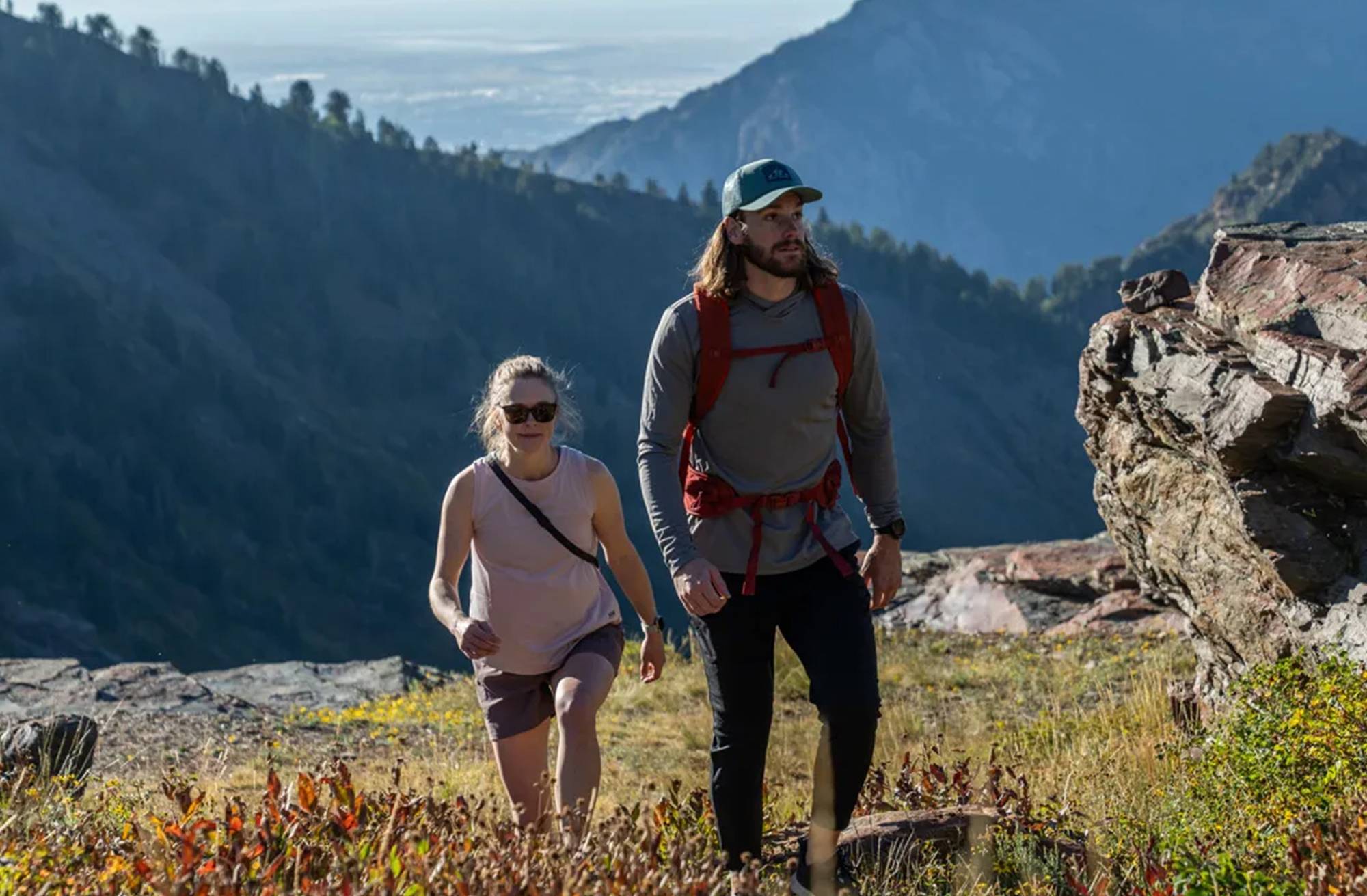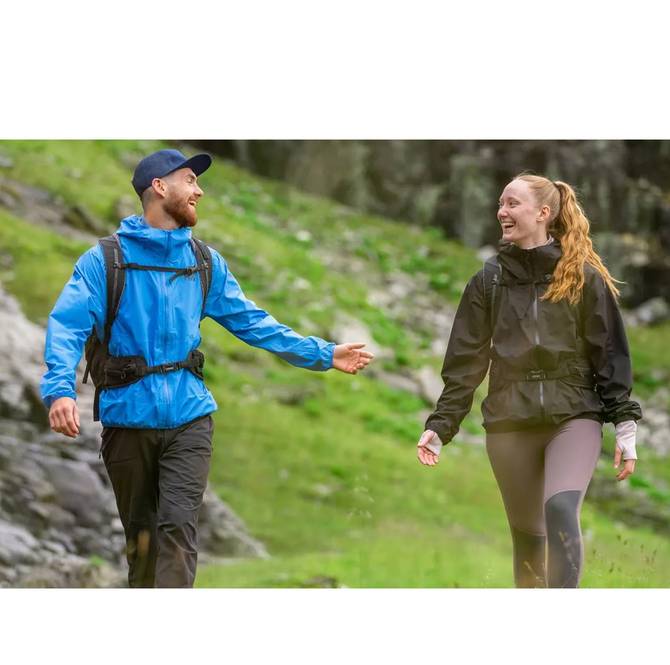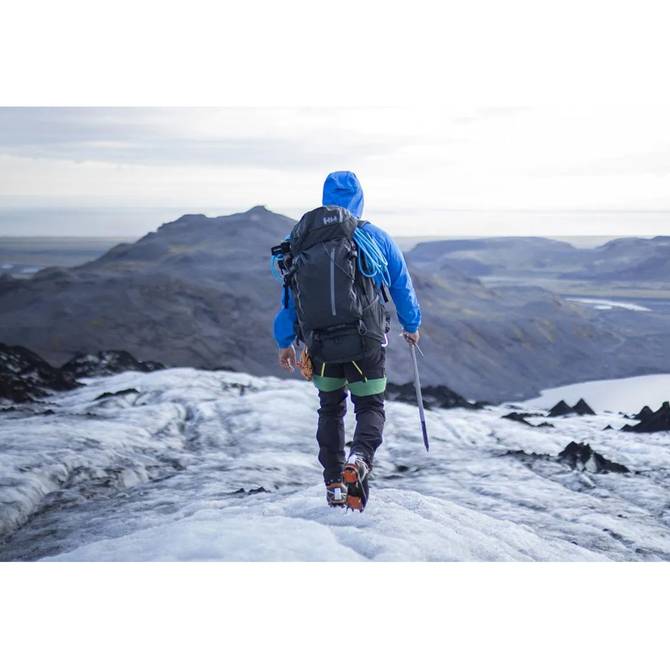Whether you’re trying a new trail or heading all the way to the summit, we cover the basics of what to wear hiking for all types of conditions.
Watch the video to learn how to layer for cold weather with moisture-wicking, insulating, and waterproof clothing. Discover tips for mild weather hiking, including convertible pants and an extra jacket for chilly moments. Get advice on hot weather hiking, focusing on lightweight, breathable clothing with UPF protection. Stay one step ahead with these expert tips from Sofia, our Category Manager, Mountain.
Essential Hiking clothing
Here's a quick list of what you should wear:
-Appropriate footwear: look after your feet!
-Shorts or pants: durable, stretchy, water-resistant, wind-resistant
-Sun-protective accessories: a hat or cap, sunscreen, and sunglasses
-3 layers: a wicking base layer; midlayer and a waterproof/breathable shell jacket
-Bonus: hiking socks
-Something to carry your water, phone, and sunscreen
What not to wear
-Cotton: doesn’t wick away moisture, so if you build up a sweat, it gets nasty fast.
-Denim: does not lend well to comfort/ freedom of movement for hiking
-Flimsy footwear: rubber boots and flip-flops don’t offer the same breathability and protection for hiking. If you’re hiking over multiple days, flip-flops can work for down time in and around the camp.
How to layer for hiking
You want to stay comfortable (not too warm, nor too cold). We live by the 3-layer system, which consists of:
1. Base layer: either merino wool or technical to wick away moisture as you build up heat
2. Midlayer: a fleece or active insulator to keep the warmth in
3. Shell: a waterproof/breathable shell jacket and pants protect you from wind and rain
Learn how to master the art of the 3-layer system.
Season-specific hiking clothes
Your choice of clothing depends on factors like the season, temperature, and conditions. But when it comes to terrain and altitude, you should be prepared for varying conditions within a single hike.
In lower elevations with tree cover, you'll be more sheltered, whereas higher elevations expose you to wind and the elements. But be prepared for varying conditions within a single hike.

Professional skier, Kaylin Richardson loves to stay active all year round. In the summer, she chooses technical and lightweight clothing while Tyler goes for our sun-protective hoodie and technical pants. Credit: Cam McLeod
Hot summer hiking
Any temperature above 85°F (30°C) is considered hot for hiking. In these conditions, make sun protection your number 1 priority, but keep in mind that it always gets cooler at the summit.
Protect yourself from the sun by wearing:
-A hat or cap
-Sunscreen (recommended year-round regardless of season)
-Sunglasses
-Our UPF 50 base layers
Some people prefer shorts and T-shirts, while others prefer long-sleeved tops and pants. Either way, make sure you choose breathable and technical clothing.
Stay warm at the summit with:
1. A lightweight down jacket
2. A thin pair of gloves
3. A warm beanie hat

In fall and spring, your hiking clothing needs to adapt to a wider range of conditions. Credit: Sverre Hjørnevik
Unpredictable spring and fall hiking
Spring and fall are known as shoulder seasons: temperatures can vary, as can the conditions. In addition to the 3-layer system we covered above, you want to add a warm puffy jacket between your midlayer and your shell jacket.
Puffy jackets are typically made of synthetic materials (like polyester), down, or a combination of both. Polyester is the best choice for rainy/unpredictable weather because it can keep you warm. Down is typically warmer and more lightweight but loses its ability to insulate once wet.

Hiking in cold weather requires much warmer technical clothing. Credit: Millerjord Photography
Cold weather hiking
At 40°F (4°C) or below, we're talking cold weather hiking. Staying warm is your focus. You should take extra precautions and be aware of windchill. As with fall and spring, use the 3-layer system and add a puffy jacket. However, in crisp, wintry conditions, we recommend a puffy jacket made of down, great for snack breaks and summit views.
Even in cold weather, you can work up a sweat, and the moisture will bring quite the chill after you reach the summit. Many outdoor professionals recommend packing a second base layer that you can change into when your intensity slows down and you want to stay warm.
Pay attention to your extremities:
-A pair of insulated hiking boots (and foot warmers)
-A pair of gloves or mittens (and hand warmers)
-A merino wool buff
-A wool beanie hat
-Socks (we recommend merino wool)
Accessories for cold weather hiking:
-Sunglasses and sunscreen (UV radiation is present in winter too)
-Micro spikes or crampons
-An ice axe
Hiking accessories
We're lucky to partner with some of the best in the outdoor industry, including search and rescue teams, and professional outdoor guides.
Here is what they recommend:
Navigation equipment: a map, compass, GPS device
Headlamp: plus, extra batteries
First aid kit (make sure you know how to use it)
Repair kit (consider what can break. Can you fix it with a multitool, zip ties or duct tape?)
Fire starter: lighter or waterproof matches
Food and snacks
Hydration and water
Knife
Shelter: a lightweight bivy sack
Don’t forget to bring a backpack to carry your essentials.
How to prepare for a hike
Before you even start to hike, you want to be as prepared as possible by minimising the risks. This means:
-Checking the weather forecast
-Ensuring you have the appropriate clothing and accessories
-Knowing who to call in case you find yourself in need of assistance
-Sharing your hiking plan with someone you trust.
5 takeaways
1. Layering is key: Understanding the three-layer system of base layer, midlayer, and shell jacket is essential for staying comfortable in varying weather conditions while hiking.
2. Adapt to the environment: adjust your clothing based on the season, temperature, and terrain, and be prepared for changing conditions.
3. Sun protection: during hot summer hikes, wear sunscreen, sun-protective clothing, a hat, and sunglasses.
4. Extreme weather precautions: stay warm with insulated clothing, including jackets, gloves, hats, and socks, and consider additional gear like micro spikes for safety.
5. Accessories matter: Navigation tools, a first aid kit, and enough water are crucial for safety and comfort on the trails.





